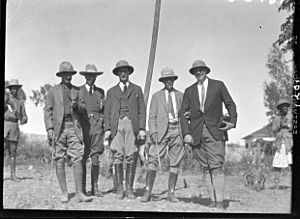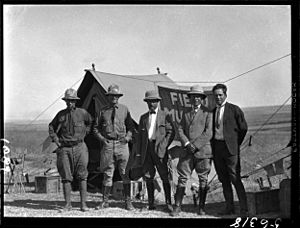C. Suydam Cutting facts for kids
Quick facts for kids
C. Suydam Cutting
|
|
|---|---|

Cutting (far left), 1927.
|
|
| Born |
Charles Suydam Cutting
January 17, 1889 New York City, New York, U.S.
|
| Died | August 24, 1972 (aged 83) |
| Education | Groton School |
| Alma mater | Harvard University |
| Spouse(s) |
Helen McMahon
(m. 1932; Mary Percy Pyne Filley
(m. 1963; |
| Parent(s) | Robert Fulton Cutting Helen Suydam Cutting |
| Relatives | Walter Lispenard Suydam (uncle) William Bayard Cutting (uncle) |
| Awards | Croix de Guerre Order of the Black Star |
Charles Suydam Cutting (January 17, 1889 – August 24, 1972) was an amazing explorer, a person who studied nature (a naturalist), and an author. He traveled all over the world on many exciting trips, including expeditions to faraway places like Ethiopia and Tibet. He was one of the first Westerners to visit the special, "forbidden" city of Lhasa in Tibet. He is also known for bringing the first Lhasa Apso dogs to the United States.
Contents
Early Life and Education
Charles Suydam Cutting was born in New York City on January 17, 1889. His father, Robert Fulton Cutting, was a well-known person in New York. Charles had several brothers and sisters.
He went to a school called the Groton School. After that, he studied at Harvard University, where he finished his engineering degree in 1912.
Career and Adventures
After college, Charles Cutting worked in engineering sales. He also served in the United States Army during both World War I and World War II. During World War II, he was a Lieutenant Colonel. He also helped a group of high-society people who secretly reported information to President Franklin D. Roosevelt.
Exploring the World
Charles Cutting loved to explore! In 1925, he went on his first big trip to Chinese Turkestan with Kermit Roosevelt and Theodore Roosevelt Jr..
He then traveled to many other places:
- Ethiopia in 1926
- Assam in 1927
- Tibet in 1928, 1930, 1935, and 1937
- The Galápagos Islands in 1930
- Celebes in 1934
- Nepal in 1937
- Upper Burma in 1939
Visiting Lhasa, Tibet
One of his most famous trips was in 1935 when he visited the city of Lhasa in Tibet. At that time, Lhasa was a "forbidden city" that was very difficult for Westerners to enter. Charles Cutting became one of the first Westerners to see it.
He managed to get permission from the Dalai Lama, the spiritual leader of Tibet. He did this by sending gifts over several years, like dachshunds, dalmatians, gold watches, and even heating equipment. The Dalai Lama even wanted an ostrich, but it was too hard to bring one!
Eventually, the Dalai Lama allowed Cutting and Arthur Stannard Vernay to enter Lhasa. During this visit, Charles Cutting received the first Lhasa Apso dogs that were brought to the United States in 1933.
After his adventures, Cutting wrote a book about his travels called The Fire Ox and Other Years. He also wrote articles for the Museum of Natural History.
Helping Animals
Charles Cutting is also known for helping to save the Galapagos tortoise from becoming extinct. And, as mentioned, he brought the first Lhasa Apso dogs to the United States, which helped start the breed there.
Personal Life
In 1932, Charles Cutting married Helen McMahon. She even joined him on his second trip to Tibet in 1937. After Helen passed away in 1961, he married Mary Percy Pyne Filley in 1963.
They had a beautiful estate in The Bahamas called "Old Fort Bay" and another home in Gladstone, New Jersey called Hamilton Farms. They often entertained friends, including the Duke and Duchess of Windsor.
Charles Cutting passed away at his summer home on Chappaquiddick Island in Edgartown, Massachusetts on August 24, 1972. He was buried in Bernardsville, New Jersey.
Awards and Honors
For his service and contributions, Charles Cutting received several honors:
- The Croix de Guerre (with a gold star) from France.
- The Order of the Black Star from France.
- He was made an honorary Commander of the Most Excellent Order of the British Empire (CBE).
Images for kids




